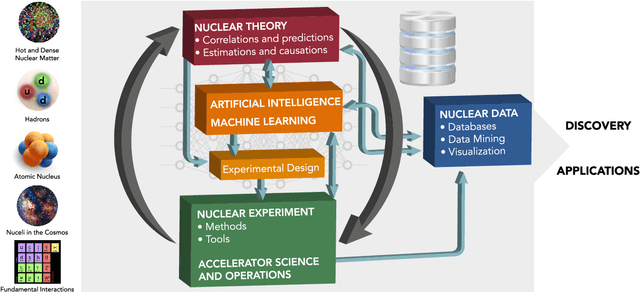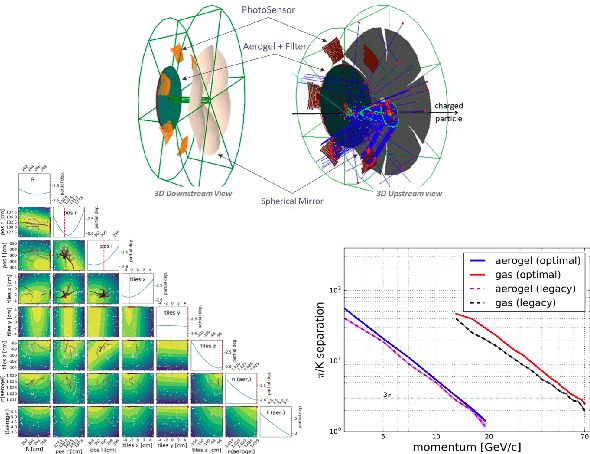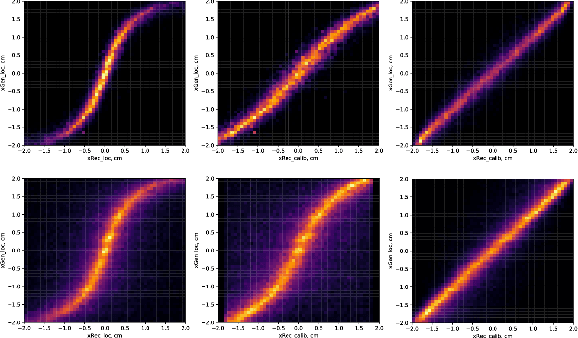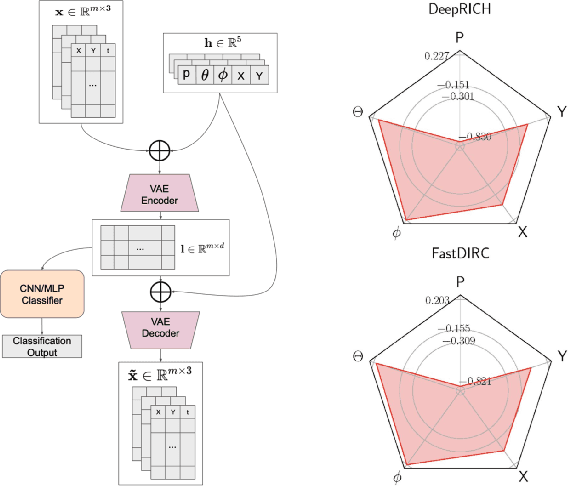Cristiano Fanelli
Towards Foundation Models for Experimental Readout Systems Combining Discrete and Continuous Data
May 13, 2025Abstract:We present a (proto) Foundation Model for Nuclear Physics, capable of operating on low-level detector inputs from Imaging Cherenkov Detectors at the future Electron Ion Collider. To address limitations in existing next-token prediction approaches-namely resolution loss from VQ-VAE tokenization and lack of conditional generation-we propose three key innovations: (i) separate vocabularies for discrete spatial features and continuous variates, combined via Causal Multi-Head Cross-Attention (CMHCA), (ii) continuous kinematic conditioning through prepended context embeddings, and (iii) scalable and simple, high-resolution continuous variate tokenization without joint vocabulary inflation. Our model enables fast, high-fidelity generation of pixel and time sequences for Cherenkov photons, validated through closure tests in the High Performance DIRC. We also show our model generalizes to reconstruction tasks such as pion and kaon identification, in which we show its ability to leverage fine-tuning.
Generative Models for Fast Simulation of Cherenkov Detectors at the Electron-Ion Collider
Apr 26, 2025Abstract:The integration of Deep Learning (DL) into experimental nuclear and particle physics has driven significant progress in simulation and reconstruction workflows. However, traditional simulation frameworks such as Geant4 remain computationally intensive, especially for Cherenkov detectors, where simulating optical photon transport through complex geometries and reflective surfaces introduces a major bottleneck. To address this, we present an open, standalone fast simulation tool for Detection of Internally Reflected Cherenkov Light (DIRC) detectors, with a focus on the High-Performance DIRC (hpDIRC) at the future Electron-Ion Collider (EIC). Our framework incorporates a suite of generative models tailored to accelerate particle identification (PID) tasks by offering a scalable, GPU-accelerated alternative to full Geant4-based simulations. Designed with accessibility in mind, our simulation package enables both DL researchers and physicists to efficiently generate high-fidelity large-scale datasets on demand, without relying on complex traditional simulation stacks. This flexibility supports the development and benchmarking of novel DL-driven PID methods. Moreover, this fast simulation pipeline represents a critical step toward enabling EIC-wide PID strategies that depend on virtually unlimited simulated samples, spanning the full acceptance of the hpDIRC.
Uncertainty Quantification with Bayesian Higher Order ReLU KANs
Oct 02, 2024Abstract:We introduce the first method of uncertainty quantification in the domain of Kolmogorov-Arnold Networks, specifically focusing on (Higher Order) ReLUKANs to enhance computational efficiency given the computational demands of Bayesian methods. The method we propose is general in nature, providing access to both epistemic and aleatoric uncertainties. It is also capable of generalization to other various basis functions. We validate our method through a series of closure tests, including simple one-dimensional functions and application to the domain of (Stochastic) Partial Differential Equations. Referring to the latter, we demonstrate the method's ability to correctly identify functional dependencies introduced through the inclusion of a stochastic term. The code supporting this work can be found at https://github.com/wmdataphys/Bayesian-HR-KAN
Unmasking Social Bots: How Confident Are We?
Jul 18, 2024



Abstract:Social bots remain a major vector for spreading disinformation on social media and a menace to the public. Despite the progress made in developing multiple sophisticated social bot detection algorithms and tools, bot detection remains a challenging, unsolved problem that is fraught with uncertainty due to the heterogeneity of bot behaviors, training data, and detection algorithms. Detection models often disagree on whether to label the same account as bot or human-controlled. However, they do not provide any measure of uncertainty to indicate how much we should trust their results. We propose to address both bot detection and the quantification of uncertainty at the account level - a novel feature of this research. This dual focus is crucial as it allows us to leverage additional information related to the quantified uncertainty of each prediction, thereby enhancing decision-making and improving the reliability of bot classifications. Specifically, our approach facilitates targeted interventions for bots when predictions are made with high confidence and suggests caution (e.g., gathering more data) when predictions are uncertain.
Deep(er) Reconstruction of Imaging Cherenkov Detectors with Swin Transformers and Normalizing Flow Models
Jul 10, 2024Abstract:Imaging Cherenkov detectors are crucial for particle identification (PID) in nuclear and particle physics experiments. Fast reconstruction algorithms are essential for near real-time alignment, calibration, data quality control, and efficient analysis. At the future Electron-Ion Collider (EIC), the ePIC detector will feature a dual Ring Imaging Cherenkov (dual-RICH) detector in the hadron direction, a Detector of Internally Reflected Cherenkov (DIRC) in the barrel, and a proximity focus RICH in the electron direction. This paper focuses on the DIRC detector, which presents complex hit patterns and is also used for PID of pions and kaons in the GlueX experiment at JLab. We present Deep(er)RICH, an extension of the seminal DeepRICH work, offering improved and faster PID compared to traditional methods and, for the first time, fast and accurate simulation. This advancement addresses a major bottleneck in Cherenkov detector simulations involving photon tracking through complex optical elements. Our results leverage advancements in Vision Transformers, specifically hierarchical Swin Transformer and normalizing flows. These methods enable direct learning from real data and the reconstruction of complex topologies. We conclude by discussing the implications and future extensions of this work, which can offer capabilities for PID for multiple cutting-edge experiments like the future EIC.
Physics Event Classification Using Large Language Models
Apr 05, 2024Abstract:The 2023 AI4EIC hackathon was the culmination of the third annual AI4EIC workshop at The Catholic University of America. This workshop brought together researchers from physics, data science and computer science to discuss the latest developments in Artificial Intelligence (AI) and Machine Learning (ML) for the Electron Ion Collider (EIC), including applications for detectors, accelerators, and experimental control. The hackathon, held on the final day of the workshop, involved using a chatbot powered by a Large Language Model, ChatGPT-3.5, to train a binary classifier neutrons and photons in simulated data from the \textsc{GlueX} Barrel Calorimeter. In total, six teams of up to four participants from all over the world took part in this intense educational and research event. This article highlights the hackathon challenge, the resources and methodology used, and the results and insights gained from analyzing physics data using the most cutting-edge tools in AI/ML.
Towards a RAG-based Summarization Agent for the Electron-Ion Collider
Mar 26, 2024Abstract:The complexity and sheer volume of information encompassing documents, papers, data, and other resources from large-scale experiments demand significant time and effort to navigate, making the task of accessing and utilizing these varied forms of information daunting, particularly for new collaborators and early-career scientists. To tackle this issue, a Retrieval Augmented Generation (RAG)--based Summarization AI for EIC (RAGS4EIC) is under development. This AI-Agent not only condenses information but also effectively references relevant responses, offering substantial advantages for collaborators. Our project involves a two-step approach: first, querying a comprehensive vector database containing all pertinent experiment information; second, utilizing a Large Language Model (LLM) to generate concise summaries enriched with citations based on user queries and retrieved data. We describe the evaluation methods that use RAG assessments (RAGAs) scoring mechanisms to assess the effectiveness of responses. Furthermore, we describe the concept of prompt template-based instruction-tuning which provides flexibility and accuracy in summarization. Importantly, the implementation relies on LangChain, which serves as the foundation of our entire workflow. This integration ensures efficiency and scalability, facilitating smooth deployment and accessibility for various user groups within the Electron Ion Collider (EIC) community. This innovative AI-driven framework not only simplifies the understanding of vast datasets but also encourages collaborative participation, thereby empowering researchers. As a demonstration, a web application has been developed to explain each stage of the RAG Agent development in detail.
ELUQuant: Event-Level Uncertainty Quantification in Deep Inelastic Scattering
Oct 04, 2023Abstract:We introduce a physics-informed Bayesian Neural Network (BNN) with flow approximated posteriors using multiplicative normalizing flows (MNF) for detailed uncertainty quantification (UQ) at the physics event-level. Our method is capable of identifying both heteroskedastic aleatoric and epistemic uncertainties, providing granular physical insights. Applied to Deep Inelastic Scattering (DIS) events, our model effectively extracts the kinematic variables $x$, $Q^2$, and $y$, matching the performance of recent deep learning regression techniques but with the critical enhancement of event-level UQ. This detailed description of the underlying uncertainty proves invaluable for decision-making, especially in tasks like event filtering. It also allows for the reduction of true inaccuracies without directly accessing the ground truth. A thorough DIS simulation using the H1 detector at HERA indicates possible applications for the future EIC. Additionally, this paves the way for related tasks such as data quality monitoring and anomaly detection. Remarkably, our approach effectively processes large samples at high rates.
Design of Detectors at the Electron Ion Collider with Artificial Intelligence
Mar 15, 2022



Abstract:Artificial Intelligence (AI) for design is a relatively new but active area of research across many disciplines. Surprisingly when it comes to designing detectors with AI this is an area at its infancy. The Electron Ion Collider is the ultimate machine to study the strong force. The EIC is a large-scale experiment with an integrated detector that extends for about $\pm$35 meters to include the central, far-forward, and far-backward regions. The design of the central detector is made by multiple sub-detectors, each in principle characterized by a multidimensional design space and multiple design criteria also called objectives. Simulations with Geant4 are typically compute intensive, and the optimization of the detector design may include non-differentiable terms as well as noisy objectives. In this context, AI can offer state of the art solutions to solve complex combinatorial problems in an efficient way. In particular, one of the proto-collaborations, ECCE, has explored during the detector proposal the possibility of using multi-objective optimization to design the tracking system of the EIC detector. This document provides an overview of these techniques and recent progress made during the EIC detector proposal. Future high energy nuclear physics experiments can leverage AI-based strategies to design more efficient detectors by optimizing their performance driven by physics criteria and minimizing costs for their realization.
Artificial Intelligence and Machine Learning in Nuclear Physics
Dec 04, 2021



Abstract:Advances in artificial intelligence/machine learning methods provide tools that have broad applicability in scientific research. These techniques are being applied across the diversity of nuclear physics research topics, leading to advances that will facilitate scientific discoveries and societal applications. This Review gives a snapshot of nuclear physics research which has been transformed by artificial intelligence and machine learning techniques.
 Add to Chrome
Add to Chrome Add to Firefox
Add to Firefox Add to Edge
Add to Edge